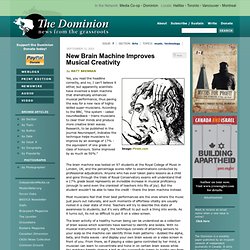

'Team Frankenstein' launch bid to build a human brain within a decade. By Allan Hall Updated: 15:48 GMT, 16 May 2011 A team of scientists has assembled in Switzerland and Germany to pursue a unique goal - the building of a computer model of a human brain.
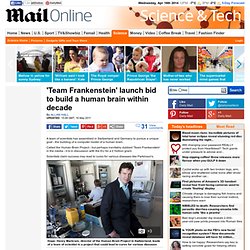
IBM Chip ‘Senses’ Events to React Like Brain. International Business Machines Corp.
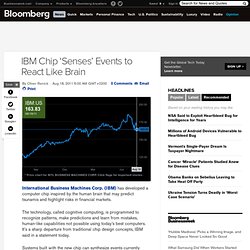
(IBM) has developed a computer chip inspired by the human brain that may predict tsunamis and highlight risks in financial markets. The technology, called cognitive computing, is programmed to recognize patterns, make predictions and learn from mistakes, human-like capabilities not possible using today’s best computers. 'Artificial life' breakthrough announced by scientists. 20 May 2010Last updated at 23:51 By Victoria Gill Science reporter, BBC News The synthetic cell looks identical to the 'wild type' Scientists in the US have succeeded in developing the first living cell to be controlled entirely by synthetic DNA.
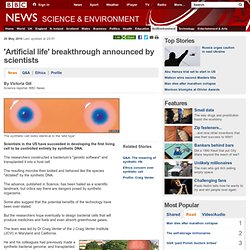
The researchers constructed a bacterium's "genetic software" and transplanted it into a host cell. Craig Venter creates synthetic life form. Scientists have created the world's first synthetic life form in a landmark experiment that paves the way for designer organisms that are built rather than evolved.

The controversial feat, which has occupied 20 scientists for more than 10 years at an estimated cost of $40m, was described by one researcher as "a defining moment in biology". Craig Venter, the pioneering US geneticist behind the experiment, said the achievement heralds the dawn of a new era in which new life is made to benefit humanity, starting with bacteria that churn out biofuels, soak up carbon dioxide from the atmosphere and even manufacture vaccines. However critics, including some religious groups, condemned the work, with one organisation warning that artificial organisms could escape into the wild and cause environmental havoc or be turned into biological weapons. Others said Venter was playing God. Craig Venter unveils "synthetic life" Evolution machine: Genetic engineering on fast forward - life - 27 June 2011.
Read full article.
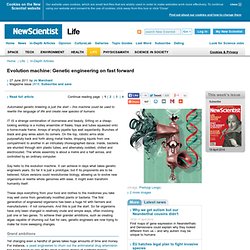
Desktop 3D Printer « 3D Printing Systems. Printing body parts: Making a bit of me. Lab-Grown Lungs - The 50 Best Inventions of 2010. Growing new body parts has always been more science fiction than science reality, but that balance may quickly be shifting, at least in the lab.
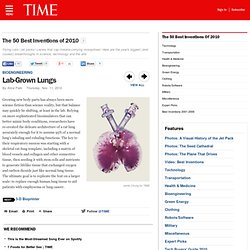
Relying on more sophisticated biosimulators that can better mimic body conditions, researchers have re-created the delicate architecture of a rat lung accurately enough for it to assume 95% of a normal lung's inhaling and exhaling functions. The key to their respiratory success was starting with a skeletal rat-lung template, including a matrix of blood vessels and collagen and other connective tissue, then seeding it with stem cells and nutrients to generate lifelike tissue that exchanged oxygen and carbon dioxide just like normal lung tissue. The ultimate goal is to replicate the feat on a larger scale: to replace enough human lung tissue to aid patients with emphysema or lung cancer.
Artificial blood vessels created on a 3D printer. 16 September 2011Last updated at 11:49 By Katia Moskvitch Technology reporter, BBC News Artificial blood vessels could help those in urgent need of an organ transplant Artificial blood vessels made on a 3D printer may soon be used for transplants of lab-created organs.

Until now, the stumbling block in tissue engineering has been supplying artificial tissue with nutrients that have to arrive via capillary vessels. ReCell Kit Grows Spray On Skin At Your Bedside In Just Half an Hour. DNA circuits used to make neural network, store memories. Even as some scientists and engineers develop improved versions of current computing technology, others are looking into drastically different approaches.
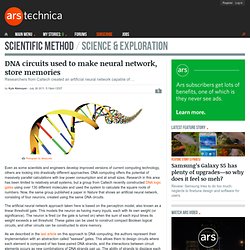
DNA computing offers the potential of massively parallel calculations with low power consumption and at small sizes. Research in this area has been limited to relatively small systems, but a group from Caltech recently constructed DNA logic gates using over 130 different molecules and used the system to calculate the square roots of numbers.
Now, the same group published a paper in Nature that shows an artificial neural network, consisting of four neurons, created using the same DNA circuits. The artificial neural network approach taken here is based on the perceptron model, also known as a linear threshold gate. Scientists Can Now Extract, Record and Return Information To the Brain. Scientists Reconstruct Brains' Visions Into Digital Video In Historic Experiment. Patient opts for amputation in favour of bionic hand. Digital Tattoo Gets Under Your Skin to Monitor Blood. Bioengineering doctoral student Kate Balaconis shines the iPhone reader against her tattooless arm.
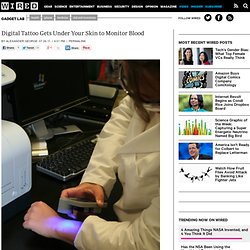
Maybe tattoos aren’t just for Harley riders or rebellious teens after all. In a few years, diabetics might get inked up with digital tats that communicate with an iPhone to monitor their blood. Instead of the dye used for tribal arm bands and Chinese characters, these tattoos will contain nanosensors that read the wearer’s blood levels of sodium, glucose and even alcohol with the help of an iPhone 4 camera. Dr. Heather Clark, associate professor of pharmaceutical sciences at Northeastern University, is leading the research on the subdermal sensors. New Brain Machine Improves Musical Creativity. September 12, 2003 by Matt Brennan The Dominion - Yes, you read the headline correctly, and no, I can't believe it either, but apparently scientists have invented a brain machine that dramatically enhances musical performance, thus paving the way for a new race of highly skilled super-musicians.
